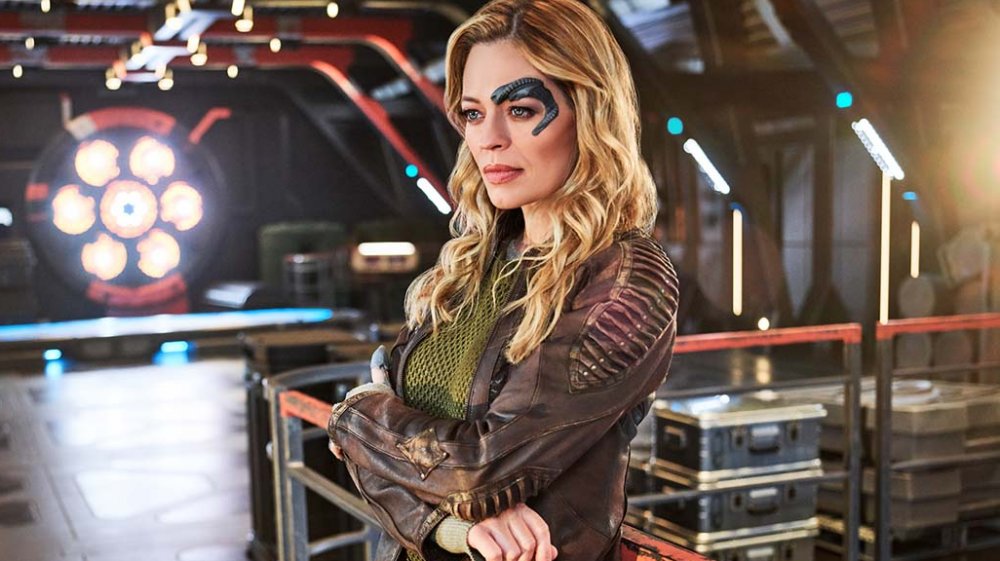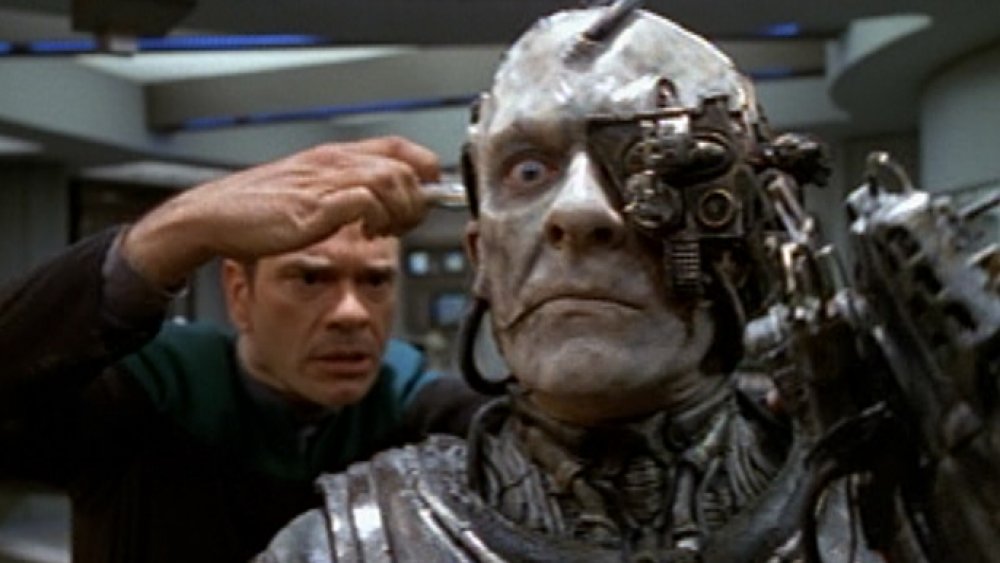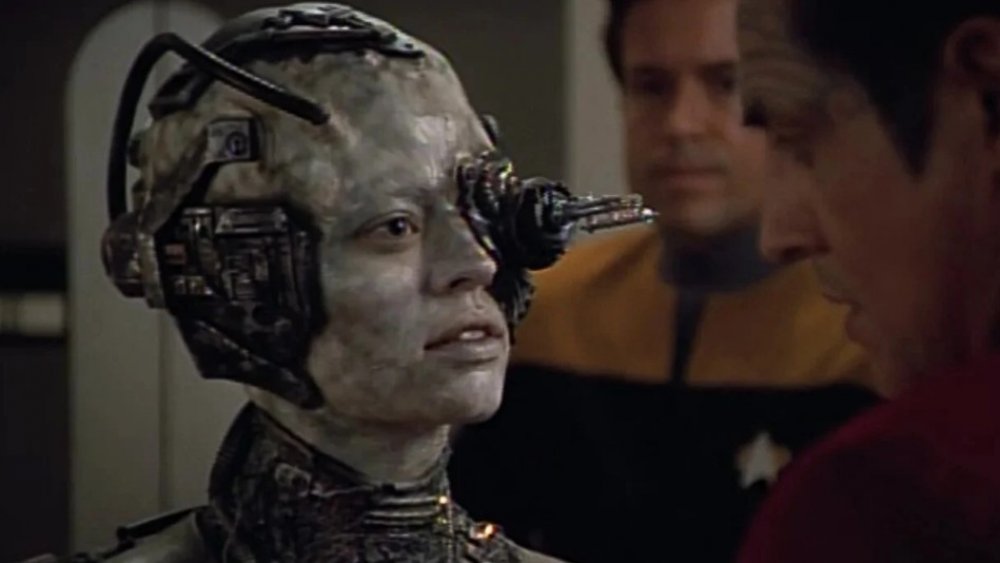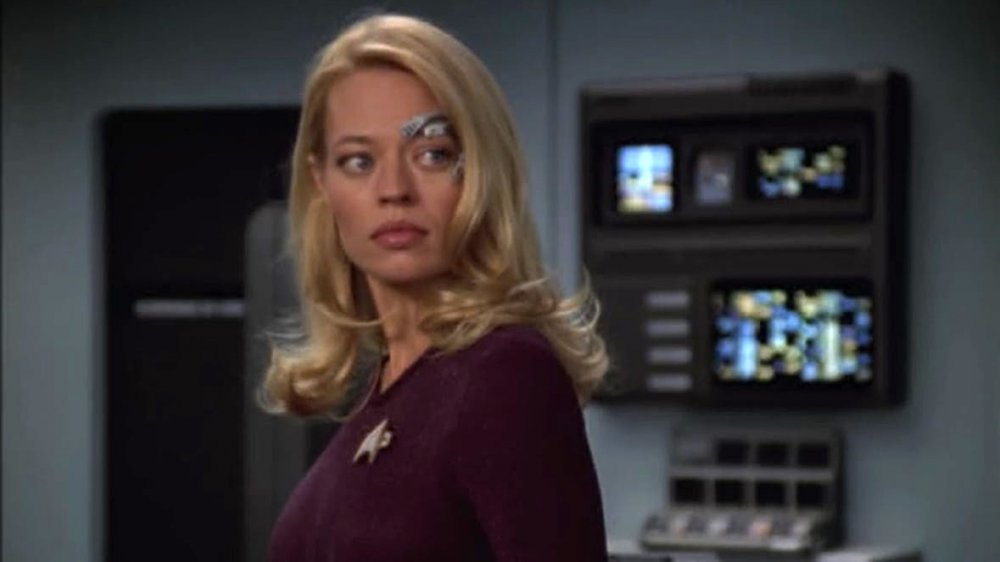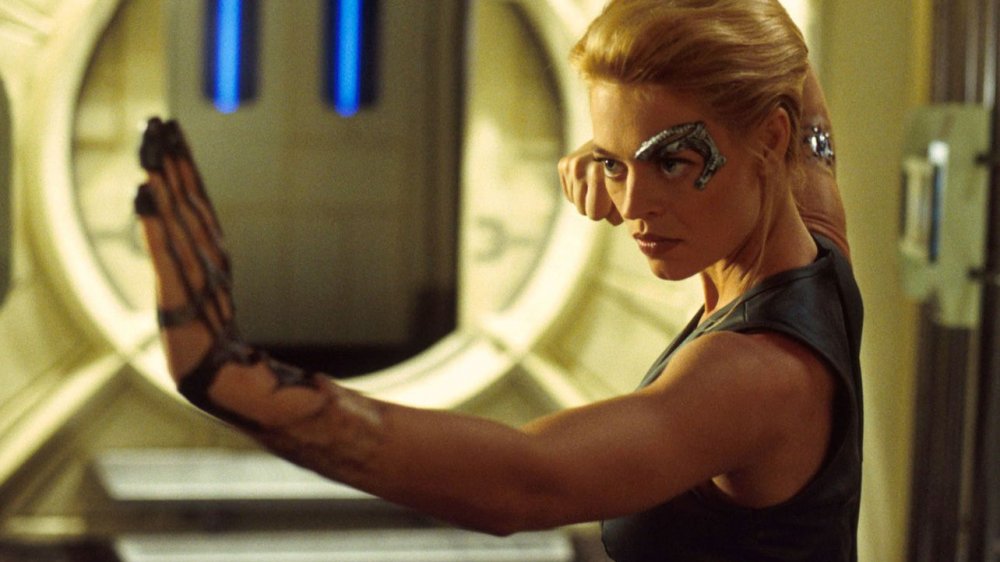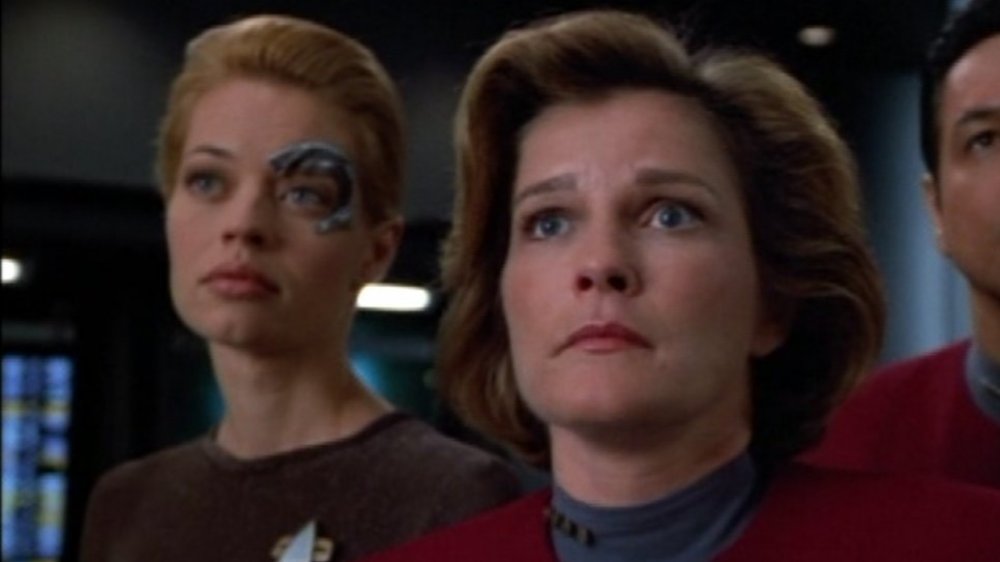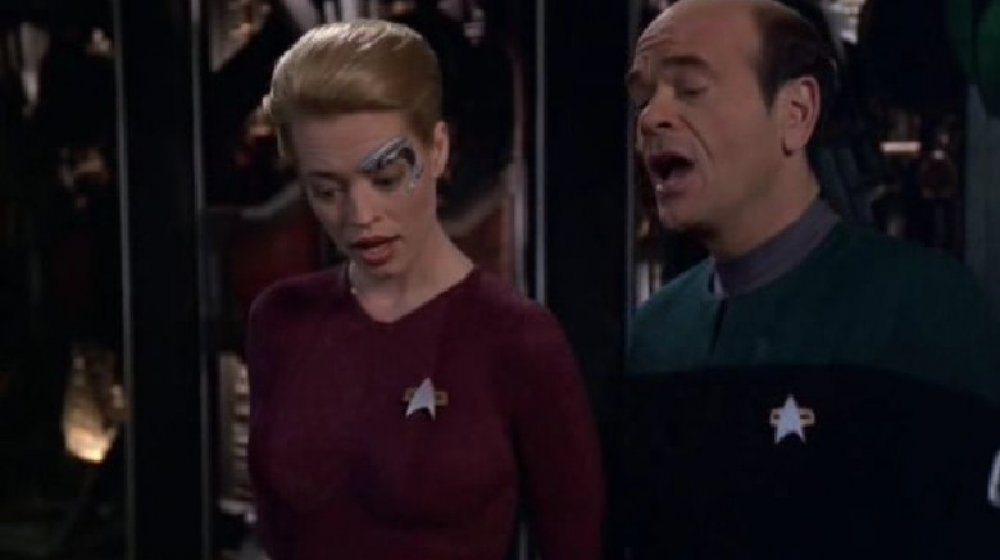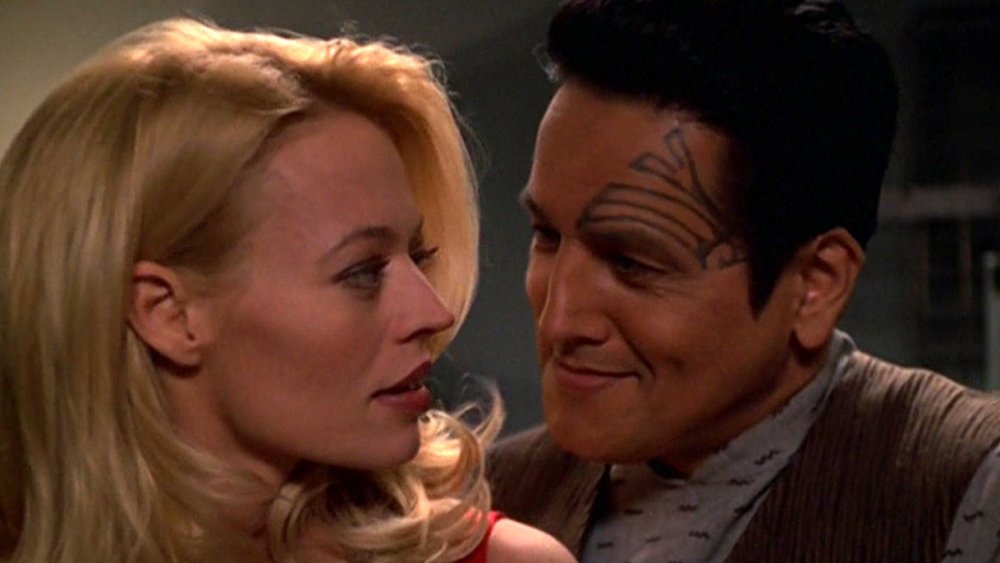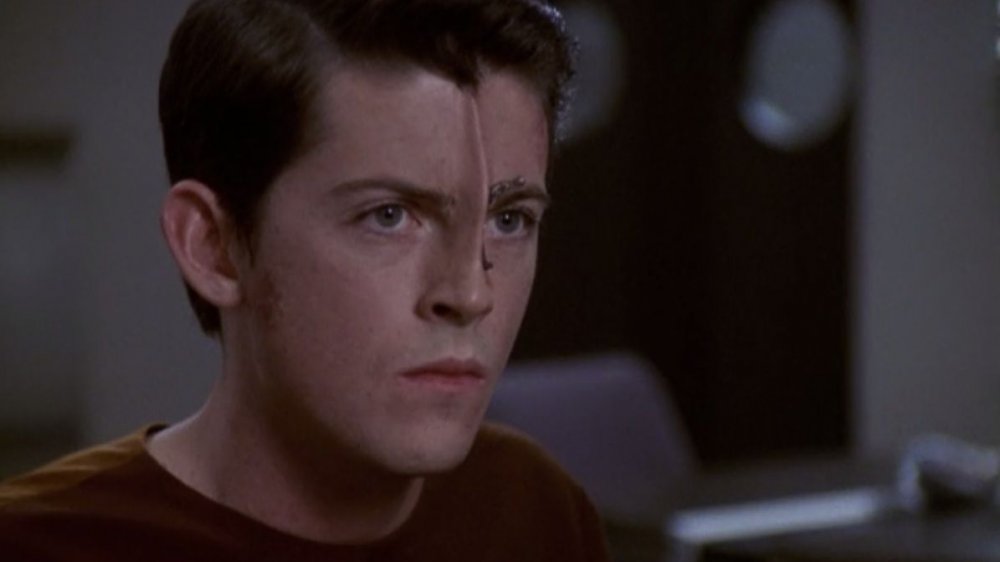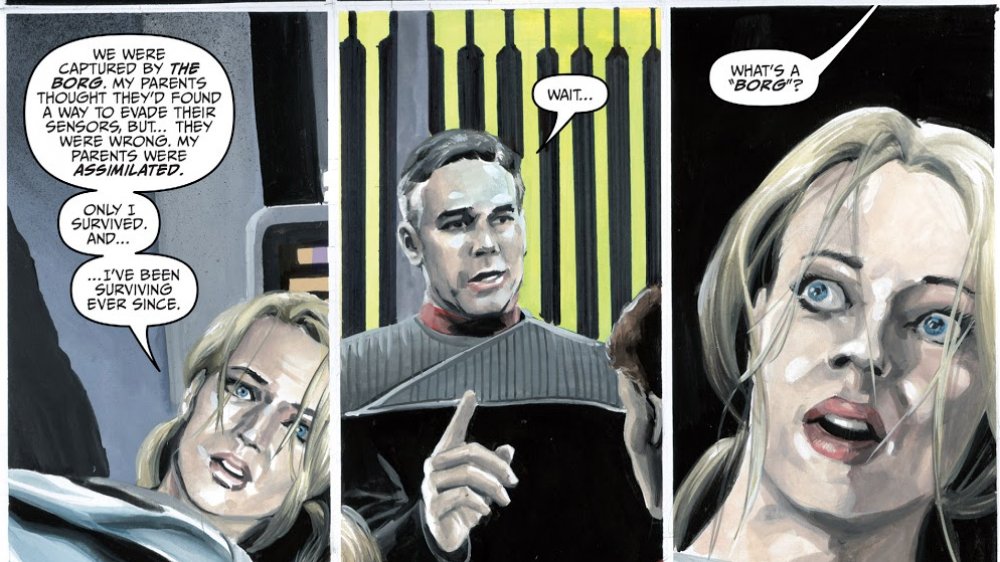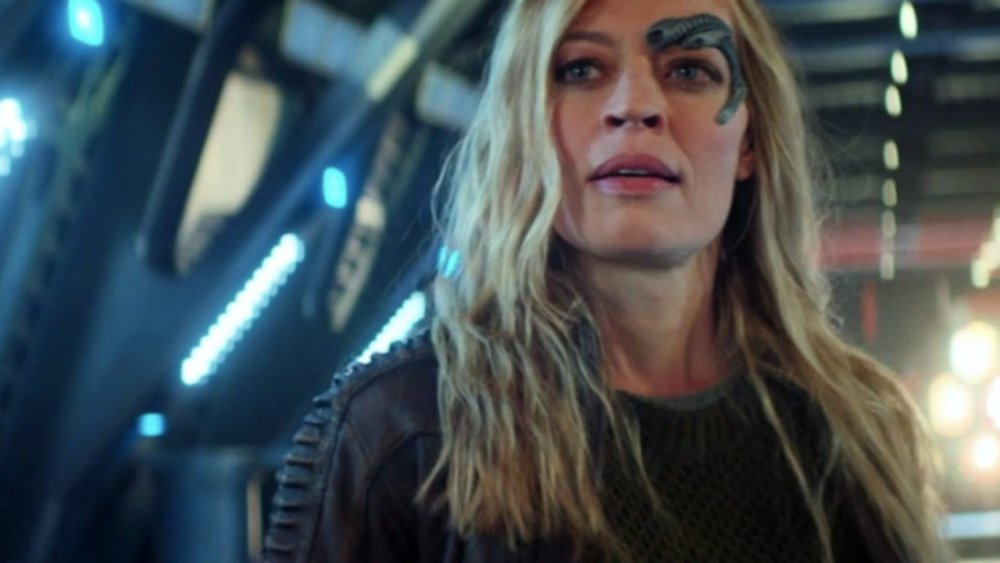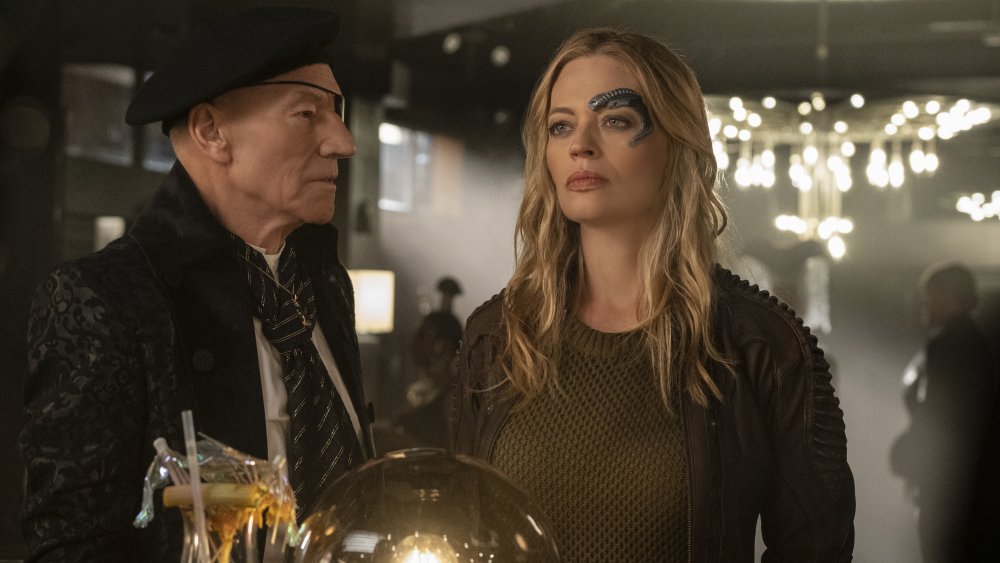The Untold Truth Of Seven Of Nine
Some of the most popular good guys are former bad guys. In Star Trek, there's no more perfect example of this than Jeri Ryan's Seven of Nine — a former member of the villainous Borg who became a fan favorite character on Star Trek: Voyager.
One of the more singular aspects of Seven's character is how popular she became in spite of how late she showed up. Seven of Nine isn't introduced to Voyager until the season 4 premiere. Few regular characters introduced so late in a Trek series have proven quite so successful. But while her sex appeal, her ongoing struggles to resolve her Borg upbringing with her humanity, and her more badass posturing proved a hit with fans, it's clear her introduction to Voyager wasn't universally embraced behind the camera.
Regardless, Seven of Nine's popularity endures. Not only does she remain one of fans' most beloved Trek heroes of the past, her story has proven to continue beyond Voyager to the franchise's 21st century series. To learn about how a character named after a couple of numbers could earn so much adulation, keep reading for the untold truth of Seven of Nine.
Seven was inspired by an earlier episode
The special feature "Braving the Unknown" on Star Trek: Voyager's season 4 home release reveals where the idea for Seven of Nine came from. Brannon Braga — a producer and writer on Voyager — says the notion of a Borg character joining the crew came to him while watching an ad for the season 3 episode "Unity."
In the episode, Commander Chakotay (Robert Beltran) finds a planet of Borg who have been disconnected from the Collective. Unfortunately, conflict rages on the planet as rivalries between different species re-emerge once ties to the Borg have been severed. An ex-Borg human named Riley (Lori Hallier) wants Voyager's help to create a new collective on the planet in order to restore harmony. In the meantime, Riley and other ex-Borgs temporarily connect Chakotay to their collective in order to heal life-threatening wounds and, eventually, to use that connection to force Voyager's First Officer to help them. Fittingly, Chakotay's experience in "Unity" becomes crucial in Voyager's early dealings with Seven of Nine.
Braga said after watching the promo for "Unity" he called other Voyager writer/producer Joe Menosky and co-creator Rick Berman "to make sure it wasn't a stupid idea." The consensus was that it was just the opposite. Braga said he and Berman "talked about it for a couple of hours and we just thought, 'This is a really cool idea. This could be really just the thing we need."
Seven, Ambassador of Borg
When Seven of Nine first comes aboard Voyager, she isn't there as a friend. She first appears in "Scorpion, Part II," the season 4 premiere of Voyager.
Upon entering the area of space dominated by the Borg — a necessary hurdle on their journey back home — the crew of Voyager discovers that the Borg have bitten off more than they can chew. A race of vicious extra-dimensional aliens known only as Species 8472 is waging war on the Borg and winning. Captain Janeway (Kate Mulgrew) decides to use this to her advantage. After the Doctor (Robert Picardo) devises a technology that can defeat Species 8472, Janeway offers it to the Borg in exchange for safe passage through their space. The Borg assign Seven of Nine — a human assimilated when she was a child — to act as liaison to Voyager's crew.
Once Species 8472 is defeated, Seven of Nine predictably turns on the crew of Voyager. She tells them their agreement is over and the Borg will assimilate the ship and her crew. Expecting the betrayal, Janeway signals for her secret plan to be put in motion. Elsewhere on the ship, the Doctor puts a neuro-transceiver on Chakotay's neck which — because of his previous experience with ex-Borg — the First Officer is able to use to connect with Seven and distract her while Lt. Torres (Roxann Dawson) cuts Seven's connection to the Collective.
Barbie of Borg
It didn't take long for some fans to call Seven of Nine "Barbie of Borg" among other, more explicit nicknames. The jokes suggested some fans thought Seven of Nine was brought on board mainly for sex appeal. From what we've heard from the creators and actors since Voyager's finale, it seems clear they weren't all that wrong. After all, while Brannon Braga's initial conception was just for a Borg crew member, when talking about that inspiration on the Voyager season 4 home release, he said it was co-creator Rick Berman who said "Make it a Borg babe."
Jeri Ryan has no illusions about how much sex appeal played into her character's popularity, but she also feels her character offered a lot more regardless. Speaking to HuffPost in 2012, Ryan said, "I don't have a problem with Seven's overtly sexual physical appearance, if only because of the way she was written and developed. If it was a crappy character, then OK. But she was so nuanced and beautifully written."
Ryan has a point. After all, once she's introduced on Voyager, so many stories revolve around Seven and her relationships with the rest of the crew. Without a layered, interesting character, none of those stories would have been possible. Fans may have shown up for the "eye candy," but they stayed for the stories.
She was meant to die
Making recurring appearances on Star Trek: Picard, Seven of Nine is one of the only Voyager regular characters to show up in the franchise after the show's finale. It's ironic, considering that Brannon Braga planned for her to be one of the only regular characters to not even survive Voyager.
Speaking to TrekCore in 2013, Braga fielded a question about some fans feeling Voyager had "de-fanged" the Borg as villains. After talking about the Borg for a bit, he revealed his own ideas for Seven's fate: "I think Seven of Nine should have bit the dust. I think there had to be a real sacrifice for this crew getting home; a real blood sacrifice. Seven of Nine was, for me, designed to be a character that was gonna die tragically. I planned that."
He went on to describe how he planned for that death to take place, mentioning "Human Error," one of the final season's later episodes. Seven uses the holodeck to explore her human side, including a potential romance with Chakotay. As emotions begin to emerge, the Doctor discovers there's a Borg failsafe device within her — if she becomes too human, the implant will kill her. Braga said, "It was that moment in my mind that would set up the finale, where she realized she can't live here, can't live there."
For better or worse, Braga's concept got the thumbs down, and Seven continued her quest to become more human.
Seven vs. the Captain
Whle they start off as uneasy allies, the relationship between Captain Janeway and Seven of Nine eventually grows into something not unlike that between a mother and daughter. Behind the scenes, however, it seems clear that Mulgrew and Ryan were not the best of friends.
When asked about her relationship with Ryan at the 2014 Star Trek Vegas Con, Mulgrew was diplomatic, saying, "We did not have a deep friendship." Mulgrew implied she'd initially resented Ryan's casting, saying, "It was very clear to anyone with eyes in their head that Jeri Ryan's beauty and sexual appeal were an important part of the numbers. I had thought 'damn, we were going to forgo all of this with a female captain.' But the demographics proved the audience wanted more sex and they got it in that beautiful, talented woman."
On 2013's Girl on Guy podcast, Ryan opened up about how ugly things got. She didn't specifically name Mulgrew as the actor in question, but her hints make it seem impossible for it be anyone else (e.g. she says most of her scenes were with "this person"). She gave examples of the actor refusing to let makeup and wardrobe crew work with Ryan before closeups and in some cases saying their lines to Ryan "off-camera picking their nails, thumbing through a book... without even making eye contact."
Learning to date with the Doctor
When asked what her favorite episodes of Voyager were, Jeri Ryan has shared her fond memories of episodes "when Seven was really starting to explore her humanity." In particular, she often cites season 5's "Someone to Watch Over Me."
Seven and Torres almost come to blows when the latter discovers that Seven has been observing and making notes on her and Tom Paris (Robert Duncan McNeill) in her study of mating rituals. When the Doctor suggests Seven should try dating on her own, the holographic physician becomes the reformed Borg's dating mentor. Among other things, he subjects Seven to a presentation reminiscent of a high school teacher's sex education lecture, brings her to the holodeck to try her hand at wooing holographic characters, teaches her to dance, and breaks into a sweet duet of "You Are My Sunshine."
Over the course of the episode, the Doctor realizes he's developing his own feelings for Seven. He's just about ready to open up about them when she tells him she will no longer need to be mentored because — after reviewing all the men on board — none are suitable as potential mates. The Doctor thanks Seven and keeps his longing to himself.
Some of the crew felt crowded by Seven
Robert Beltran was known for being honest — even while Voyager was still on the air — when he wasn't happy about something. And one of the things he wasn't happy about was how he felt Chakotay and other characters were short-changed once Seven of Nine came board.
Speaking to StarTrek.com in 2012, Beltran said, "when the Seven of Nine character made her entrance, the focus changed... That was fine with me, but I think writers have an obligation to fill out all the characters if they're regular characters on a series. I think several of the characters were diminished — Chakotay and Tuvok and Kim and Neelix." He went on to say he felt Seven was easier to write because she wasn't fully human.
Ryan told the Girl on Guy podcast she thought so much focus was put on Seven because, simply put, she was new. "Now the writers, who have been writing for the same seven characters for three years, are salivating for something new to write with," Ryan said. "Consequently, all the scripts revolved around Seven of Nine and her relationship with the other characters, of course."
She also said she was aware of some of the other cast's resentments and understood them, though the understanding apparently didn't make things easier. "When the new kid comes in and suddenly it's all about them. That was tough," Ryan said. "It really made it an unpleasant work experience."
Icheb, the son she never had
Seven of Nine isn't the only ex-Borg to join Voyager on its quest back to Earth. In season 6's "Collective," the crew encounters a Borg Cube whose only survivors are children. At the end of the episode, four of the children come aboard Voyager, where the Doctor uses the same techniques he used on Seven to remove most of the children's Borg implants. The oldest of the four is Icheb (Manu Intiraymi), a member of a race called the Brunali, who becomes a recurring character on Voyager.
We eventually learn that Icheb's assimilation into the Borg was somewhat unique. In "Child's Play," Icheb discovers he was genetically engineered by his parents with a deadly virus meant to eradicate the Borg. His parents willingly put him on a ship and steered him toward the Borg in the hopes they would assimilate him and subsequently be destroyed.
Unfortunately, Icheb is brutally taken away from Seven in the season 1 Star Trek: Picard episode "Stardust City Rag." In a flashback, we learn Icheb (now played by Casey King) has been captured and his body is being harvested for its cybernetic parts. Seven interrupts the procedure, but Icheb is already dying and in excruciating pain. He begs Seven to kill him, which she does while sobbing.
Seven in the Mirror
One of the most well-loved stories of any Star Trek show is the original series episode "Mirror, Mirror" in which a mirror universe is revealed where the tyrannical Terran Empire replaces the Federation, and evil counterparts of the Enterprise's crew replace the ones with which we're more familiar. Subsequent series like Deep Space Nine, Enterprise, and Discovery return to the mirror universe, though Voyager never got a chance. That's something IDW's 2019 one-shot comic Star Trek: Voyager — Mirrors & Smoke corrects.
In the mirror universe, Janeway is the Pirate Queen of the Delta Quadrant and is perfectly content to stay far from Earth, where she and her crew can plunder without anyone to interfere. In this universe, Annika Hansen was never assimilated by the Borg, but her parents were. When Voyager rescues her from Neelix and Kes, Annika discovers the Terrans know nothing about the Borg.
Ironically, while Annika isn't a Borg in this universe, she still betrays Voyager. Shortly after she's rescued, she plots with the Doctor to take over the ship and kill anyone who doesn't cooperate. Their plans are foiled, and interestingly Annika's motivations for turning against them are never revealed. Though toward the end of the comic she refers to her captors as "the humans," suggesting she may be more than she appears.
She never expected to return
One of the most anticipated appearances of Star Trek: Picard's first season was the return of Seven of Nine. She saves Picard (Patrick Stewart) and his crew at the end of "Absolute Candor," and takes center stage in the following episode "Stardust City Rag." We learn that for years Seven has been a part of a group of vigilantes called the Fenris Rangers, trying to bring justice to the galaxy in the wake of the Romulan supernova.
As much of a success as Seven's return has proven to be, Jeri Ryan never thought it would happen. On the Picard after show Ready Room, Ryan told host Wil Wheaton, "This has been a two-year process since this was first broached to me. And I didn't think it was ever going to really actually come to fruition." She said one of the series writers, James Duff, pitched the idea to her two years earlier, but she thought it was a joke.
Apparently, it wasn't until the 2018 Creative Arts Emmys when Ryan was shocked to discover her return to the role was actually a possibility. While she waited backstage, Picard co-creator Alex Kurtzman told her there was a lot of discussion about her in the series writers' room. Ryan's response? "And I was like 'What? Really? Okay. I guess it's actually happening.'"
Seven and Locutus, two of a kind
At first, it may seem strange for Seven of Nine to show up in Star Trek: Picard. After all, the character wasn't around for Star Trek: The Next Generation and we've never seen the two characters meet before Picard, but if you stop to think about it, Seven may have more in common with Picard than anyone he served with aboard the Enterprise.
In the two-part TNG episode "Best of Both Worlds," Picard is assimilated by the Borg and turned into Locutus. The Collective uses his memories and knowledge to kill Picard's Starfleet comrades. He's eventually saved by his crew, but the experience leaves deep scars. We see him suffering from it in subsequent episodes as well as in 1996's Star Trek: First Contact.
While Seven was assimilated when she was a young girl and spent a much longer time with the Collective than Picard, they share this terrible bond with one another. This never comes through more clearly than in an exchange toward the end of "Stardust City Rag." Seven asks Picard if he thinks he regained his humanity once he was cut off from the Borg. He says he did. Seven asks, "All of it?"
Picard answers, "No. But we're both working on it. Aren't we?"
Seven says, "Every damn day of my life."
